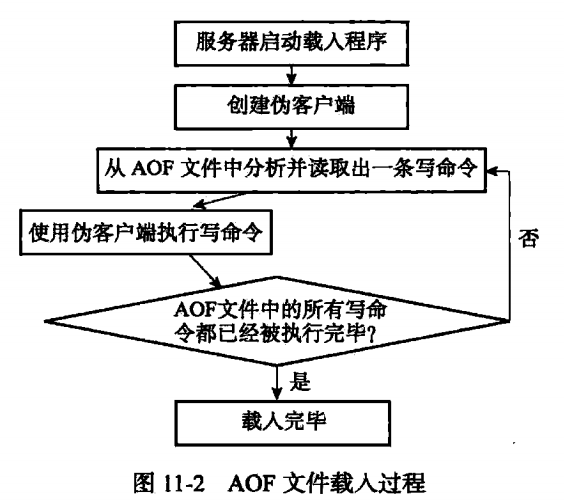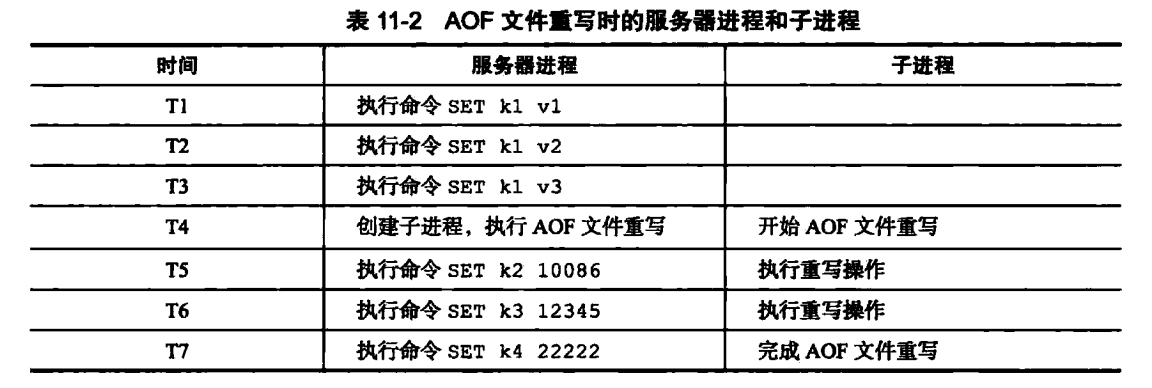Redis 設計與實現(第十章) -- 持久化AOF
概述
Redis除了RDB方式提供持久化外,還提供了AOF的方式,和RDB保存數據庫的鍵值對不同,AOF是記錄數據庫執行的命令來記錄數據庫狀態的。當AOF開始時,Redis服務器加載時,會先檢查AOF文件是否存在,如果存在,則加載AOF,否則加載RDB文件。本章主要分為:
1.AOF實現
2.AOF文件載入與還原
3.AOF重寫及實現
AOF實現
AOF持久化功能的實現可以分為命令追加、文件寫入、文件同步三個步驟。
命令追加
當AOF持久化功能處於打開狀態時,服務器在執行完一個寫命令之後,會以協議格式將被執行的寫命令追加到AOF_BUF緩沖區的末尾,可以看下redisServer的數據庫數據結構中,有包含這一屬性:
/* AOF persistence */ int aof_state; /* REDIS_AOF_(ON|OFF|WAIT_REWRITE) */ int aof_fsync; /* Kind of fsync() policy */ char *aof_filename; /* Name of the AOF file */ int aof_no_fsync_on_rewrite; /* Don‘t fsync if a rewrite is in prog. */ intaof_rewrite_perc; /* Rewrite AOF if % growth is > M and... */ off_t aof_rewrite_min_size; /* the AOF file is at least N bytes. */ off_t aof_rewrite_base_size; /* AOF size on latest startup or rewrite. */ off_t aof_current_size; /* AOF current size. */ int aof_rewrite_scheduled; /*Rewrite once BGSAVE terminates. */ pid_t aof_child_pid; /* PID if rewriting process */ list *aof_rewrite_buf_blocks; /* Hold changes during an AOF rewrite. */ sds aof_buf; /* AOF buffer, written before entering the event loop ,且類型為SDS*/ int aof_fd; /* File descriptor of currently selected AOF file */ int aof_selected_db; /* Currently selected DB in AOF */
比如在客戶端執行命令,set key value,服務器執行完這個命令後,會將命令轉換為以下格式追加到緩沖區末尾:
![]()
文件寫入與同步
Redis服務器就是一個事件循環,這個循環中的文件事件復雜客戶端的請求以及回復,而時間事件就是執行像serverCron這樣需要定時執行的函數。
在服務器處理文件事件時,可能會執行寫命令,會有一些寫命令被追加到AOF緩沖區。所以在服務器結束一個文件事件前,會調用flushAppendOnlyFile函數還判斷是否需要到緩沖區的內容進行保存到AOF文件,函數的源碼如下:
void flushAppendOnlyFile(int force) { ssize_t nwritten; int sync_in_progress = 0; mstime_t latency; if (sdslen(server.aof_buf) == 0) return; //判斷緩沖區大小 if (server.aof_fsync == AOF_FSYNC_EVERYSEC) //判斷AOF配置 sync_in_progress = bioPendingJobsOfType(REDIS_BIO_AOF_FSYNC) != 0; if (server.aof_fsync == AOF_FSYNC_EVERYSEC && !force) { /* With this append fsync policy we do background fsyncing. * If the fsync is still in progress we can try to delay * the write for a couple of seconds. */ if (sync_in_progress) { if (server.aof_flush_postponed_start == 0) { /* No previous write postponing, remember that we are * postponing the flush and return. */ server.aof_flush_postponed_start = server.unixtime; return; } else if (server.unixtime - server.aof_flush_postponed_start < 2) { /* We were already waiting for fsync to finish, but for less * than two seconds this is still ok. Postpone again. */ return; } /* Otherwise fall trough, and go write since we can‘t wait * over two seconds. */ server.aof_delayed_fsync++; redisLog(REDIS_NOTICE,"Asynchronous AOF fsync is taking too long (disk is busy?). Writing the AOF buffer without waiting for fsync to complete, this may slow down Redis."); } }
append_fsync有三種選項,默認為AOF_FSYNC_EVERYSEC:

AOF文件的載入
生成AOF文件後,會啟動服務器時,會優先加載AOF文件,怎麽去加載呢?
首先,Redis server會fork一個無網絡連接的偽客戶端(因為redis命令只能從客戶端執行,前面講了AOF文件保存的是執行的命令),接下來就是從AOF文件中讀取並解析一行命令,並通過偽客戶端來執行該命令。然後循環讀取文件、解析、執行。具體過程如下:

AOF重寫
前面有講到,AOF文件保存的是執行的命令,比如先在Redis客戶端執行了四條命令,set msg 1,set msg 2,set msg 3,set msg 4,這樣四條命令,其實最後msg的值為4,我們只需要保存最後一條命令即可,但是如果按照之前的實現,我們需要保存4條命令。正是由於這種機制,所以AOF文件會越來越大,而且會有很多類似這種情況的命令。體積過大不僅可能影響主機,更加會影響到載入及還原的時間,所以我們需要對AOF文件進行重寫,以減少體積。類似上面這種情況,在AOF重寫後,只需要有一條命令就夠了。那AOF是怎麽實現的呢?
實現
雖然Redis中這個功能叫做AOF重寫,但是並沒有對現有的AOF文件進行任何讀取,分析,寫入操作,這個功能實際上是通過讀取服務器當前的數據庫狀態實現的。
還是拿上面的set msg的幾條命令來舉例,保存到AOF時,會有4條命令,這時候最快的速度不是去分析AOF文件,而且直接從數據庫中取出msg的內容為4,再通過命令set msg 4保存到新的AOF文件中。其他類型的list,hash等都是類似的操作。所以AOF重寫後只有一條命令。源碼如下:

int rewriteAppendOnlyFile(char *filename) { dictIterator *di = NULL; dictEntry *de; rio aof; FILE *fp; char tmpfile[256]; int j; long long now = mstime(); char byte; size_t processed = 0; /* Note that we have to use a different temp name here compared to the * one used by rewriteAppendOnlyFileBackground() function. */ snprintf(tmpfile,256,"temp-rewriteaof-%d.aof", (int) getpid()); fp = fopen(tmpfile,"w"); if (!fp) { redisLog(REDIS_WARNING, "Opening the temp file for AOF rewrite in rewriteAppendOnlyFile(): %s", strerror(errno)); return REDIS_ERR; } server.aof_child_diff = sdsempty(); rioInitWithFile(&aof,fp); if (server.aof_rewrite_incremental_fsync) rioSetAutoSync(&aof,REDIS_AOF_AUTOSYNC_BYTES); for (j = 0; j < server.dbnum; j++) { char selectcmd[] = "*2\r\n$6\r\nSELECT\r\n"; redisDb *db = server.db+j; dict *d = db->dict; if (dictSize(d) == 0) continue; di = dictGetSafeIterator(d); if (!di) { fclose(fp); return REDIS_ERR; } /* SELECT the new DB */ if (rioWrite(&aof,selectcmd,sizeof(selectcmd)-1) == 0) goto werr; if (rioWriteBulkLongLong(&aof,j) == 0) goto werr; /* Iterate this DB writing every entry */ while((de = dictNext(di)) != NULL) { sds keystr; robj key, *o; long long expiretime; keystr = dictGetKey(de); o = dictGetVal(de); initStaticStringObject(key,keystr); expiretime = getExpire(db,&key); /* If this key is already expired skip it */ if (expiretime != -1 && expiretime < now) continue; /* Save the key and associated value */ if (o->type == REDIS_STRING) { /* Emit a SET command */ char cmd[]="*3\r\n$3\r\nSET\r\n"; if (rioWrite(&aof,cmd,sizeof(cmd)-1) == 0) goto werr; /* Key and value */ if (rioWriteBulkObject(&aof,&key) == 0) goto werr; if (rioWriteBulkObject(&aof,o) == 0) goto werr; } else if (o->type == REDIS_LIST) { if (rewriteListObject(&aof,&key,o) == 0) goto werr; } else if (o->type == REDIS_SET) { if (rewriteSetObject(&aof,&key,o) == 0) goto werr; } else if (o->type == REDIS_ZSET) { if (rewriteSortedSetObject(&aof,&key,o) == 0) goto werr; } else if (o->type == REDIS_HASH) { if (rewriteHashObject(&aof,&key,o) == 0) goto werr; } else { redisPanic("Unknown object type"); } /* Save the expire time */ if (expiretime != -1) { char cmd[]="*3\r\n$9\r\nPEXPIREAT\r\n"; if (rioWrite(&aof,cmd,sizeof(cmd)-1) == 0) goto werr; if (rioWriteBulkObject(&aof,&key) == 0) goto werr; if (rioWriteBulkLongLong(&aof,expiretime) == 0) goto werr; } /* Read some diff from the parent process from time to time. */ if (aof.processed_bytes > processed+1024*10) { processed = aof.processed_bytes; aofReadDiffFromParent(); } } dictReleaseIterator(di); di = NULL; } /* Do an initial slow fsync here while the parent is still sending * data, in order to make the next final fsync faster. */ if (fflush(fp) == EOF) goto werr; if (fsync(fileno(fp)) == -1) goto werr; /* Read again a few times to get more data from the parent. * We can‘t read forever (the server may receive data from clients * faster than it is able to send data to the child), so we try to read * some more data in a loop as soon as there is a good chance more data * will come. If it looks like we are wasting time, we abort (this * happens after 20 ms without new data). */ int nodata = 0; mstime_t start = mstime(); while(mstime()-start < 1000 && nodata < 20) { if (aeWait(server.aof_pipe_read_data_from_parent, AE_READABLE, 1) <= 0) { nodata++; continue; } nodata = 0; /* Start counting from zero, we stop on N *contiguous* timeouts. */ aofReadDiffFromParent(); } /* Ask the master to stop sending diffs. */ if (write(server.aof_pipe_write_ack_to_parent,"!",1) != 1) goto werr; if (anetNonBlock(NULL,server.aof_pipe_read_ack_from_parent) != ANET_OK) goto werr; /* We read the ACK from the server using a 10 seconds timeout. Normally * it should reply ASAP, but just in case we lose its reply, we are sure * the child will eventually get terminated. */ if (syncRead(server.aof_pipe_read_ack_from_parent,&byte,1,5000) != 1 || byte != ‘!‘) goto werr; redisLog(REDIS_NOTICE,"Parent agreed to stop sending diffs. Finalizing AOF..."); /* Read the final diff if any. */ aofReadDiffFromParent(); /* Write the received diff to the file. */ redisLog(REDIS_NOTICE, "Concatenating %.2f MB of AOF diff received from parent.", (double) sdslen(server.aof_child_diff) / (1024*1024)); if (rioWrite(&aof,server.aof_child_diff,sdslen(server.aof_child_diff)) == 0) goto werr; /* Make sure data will not remain on the OS‘s output buffers */ if (fflush(fp) == EOF) goto werr; if (fsync(fileno(fp)) == -1) goto werr; if (fclose(fp) == EOF) goto werr; /* Use RENAME to make sure the DB file is changed atomically only * if the generate DB file is ok. */ if (rename(tmpfile,filename) == -1) { redisLog(REDIS_WARNING,"Error moving temp append only file on the final destination: %s", strerror(errno)); unlink(tmpfile); return REDIS_ERR; } redisLog(REDIS_NOTICE,"SYNC append only file rewrite performed"); return REDIS_OK; werr: redisLog(REDIS_WARNING,"Write error writing append only file on disk: %s", strerror(errno)); fclose(fp); unlink(tmpfile); if (di) dictReleaseIterator(di); return REDIS_ERR; }rewriteAppendOnlyFile
在AOF重寫時,為了不影響服務器處理其他請求,會使用子進程來處理AOF的重寫。但是這樣會有一個問題:在重寫AOF期間,可能會有其他客戶端請求命令過來,新的命令修改了數據庫狀態,這樣就使得服務器當前狀態和AOF文件所保存的狀態不一致。舉個例子:
在AOF重寫時,數據庫中只有一個k1值,在子進程重寫過程中,有產生了k2,k3,k4幾個鍵值,這樣AOF重寫後的狀態(k1)就與數據庫當前狀態(k1,k2,k3,k4)不一致。

為了解決這個問題,Redis設置了一個重寫緩沖區,當Redis服務器執行一個寫命令後,會同時將命令寫入到AOF緩沖區和AOF重寫緩沖區。
在子進程完成AOF重寫後,會給父進程發一個信號,父進程會再調用函數,進行以下處理:
1.將AOF重寫緩沖區的內容寫入到AOF文件,這樣AOF保存的數據庫狀態和當前數據庫狀態就一致了;
2.將新的AOF文件進行改名,原子的覆蓋現有的AOF文件,完成新舊文件的替換。

Redis 設計與實現(第十章) -- 持久化AOF

